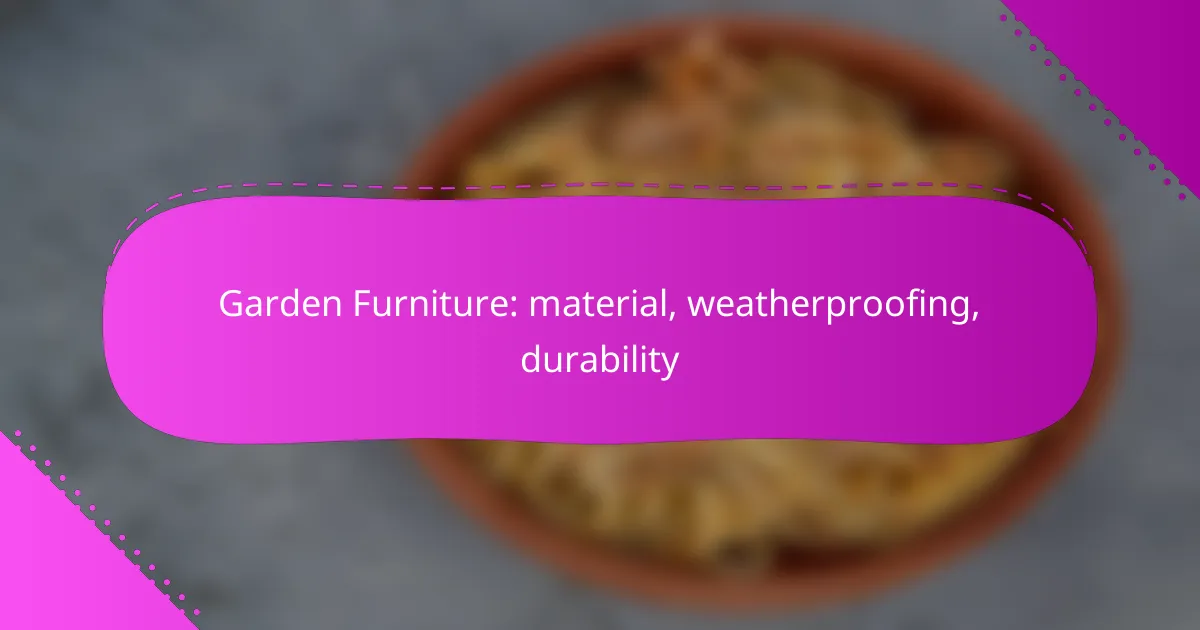When selecting garden furniture, it’s crucial to consider materials that can endure diverse weather conditions while offering durability and comfort. Options like teak wood, aluminum, wicker, plastic, and steel each provide distinct advantages, making them suitable for outdoor use. Additionally, effective weatherproofing is essential to protect furniture from moisture, UV rays, and rust, ensuring it remains functional and attractive over time.
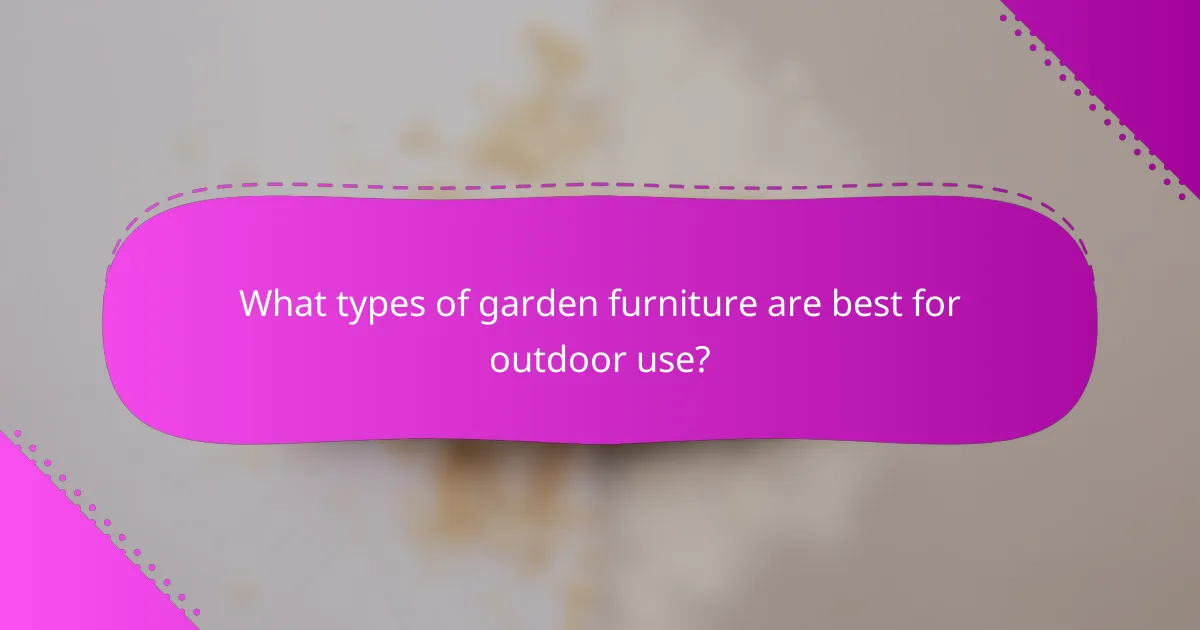
What types of garden furniture are best for outdoor use?
The best garden furniture for outdoor use is typically made from materials that withstand various weather conditions while providing durability and comfort. Key options include teak wood, aluminum, wicker, plastic, and steel, each with unique benefits and considerations.
Teak wood furniture
Teak wood furniture is renowned for its exceptional durability and resistance to the elements. Its natural oils protect it from moisture, making it ideal for outdoor settings where rain and humidity are common.
To maintain its rich color and prevent weathering, regular oiling is recommended. Teak can be more expensive than other materials, but its longevity often justifies the investment.
Aluminum furniture
Aluminum furniture is lightweight, rust-resistant, and easy to move, making it a popular choice for outdoor spaces. It can withstand harsh weather conditions without deteriorating, which is ideal for regions with fluctuating climates.
Look for powder-coated aluminum for added protection against scratches and fading. This type of furniture is typically more affordable than wood options and requires minimal maintenance.
Wicker furniture
Wicker furniture, often made from synthetic materials, offers a stylish and comfortable option for outdoor use. It is lightweight and resistant to fading and moisture, making it suitable for patios and gardens.
When choosing wicker furniture, ensure it is UV-resistant to prevent damage from sunlight. Regular cleaning with mild soap and water will help maintain its appearance and longevity.
Plastic furniture
Plastic furniture is an economical and practical choice for outdoor settings. It is lightweight, easy to clean, and resistant to moisture, making it suitable for various weather conditions.
While plastic may not have the aesthetic appeal of wood or metal, it comes in various colors and styles. Look for high-density polyethylene (HDPE) for better durability and resistance to fading.
Steel furniture
Steel furniture is known for its strength and sturdiness, making it a durable option for outdoor use. However, it is essential to choose galvanized or powder-coated steel to prevent rust and corrosion.
While heavier than aluminum, steel provides a solid feel and can withstand strong winds. Regular maintenance, such as checking for scratches and applying touch-up paint, will help extend its lifespan.
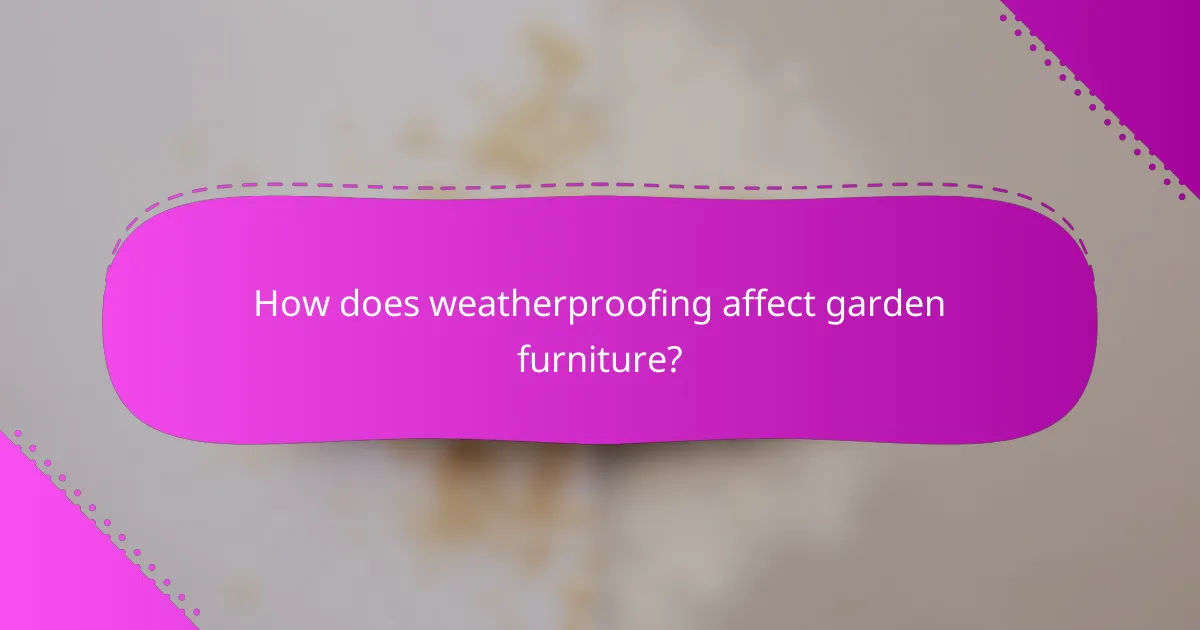
How does weatherproofing affect garden furniture?
Weatherproofing significantly enhances the longevity and usability of garden furniture by protecting it from moisture, UV rays, and rust. Properly treated furniture can withstand various weather conditions, ensuring it remains functional and visually appealing for years.
Water-resistant coatings
Water-resistant coatings create a barrier that prevents moisture from penetrating the material of garden furniture. These coatings can be applied to wood, metal, and synthetic materials, helping to reduce the risk of warping, rotting, or corrosion.
When selecting water-resistant coatings, look for products that are specifically designed for outdoor use. Regular maintenance, such as reapplication every couple of years, can help maintain the effectiveness of these coatings.
UV protection treatments
UV protection treatments shield garden furniture from the damaging effects of sunlight, which can cause fading and deterioration over time. These treatments are particularly important for materials like plastic and wood, which are prone to sun damage.
Consider using UV-resistant sprays or finishes that can be easily applied to existing furniture. Regularly checking for signs of wear and reapplying treatments as needed can help preserve the color and integrity of your outdoor pieces.
Rust-resistant finishes
Rust-resistant finishes are essential for metal garden furniture, as they prevent oxidation and corrosion caused by exposure to moisture and air. These finishes often include powder coatings or galvanization, which provide a durable protective layer.
When purchasing metal furniture, look for products that specify rust resistance. Regular cleaning and maintenance can further extend the life of these finishes, ensuring your furniture remains in good condition even in humid climates.
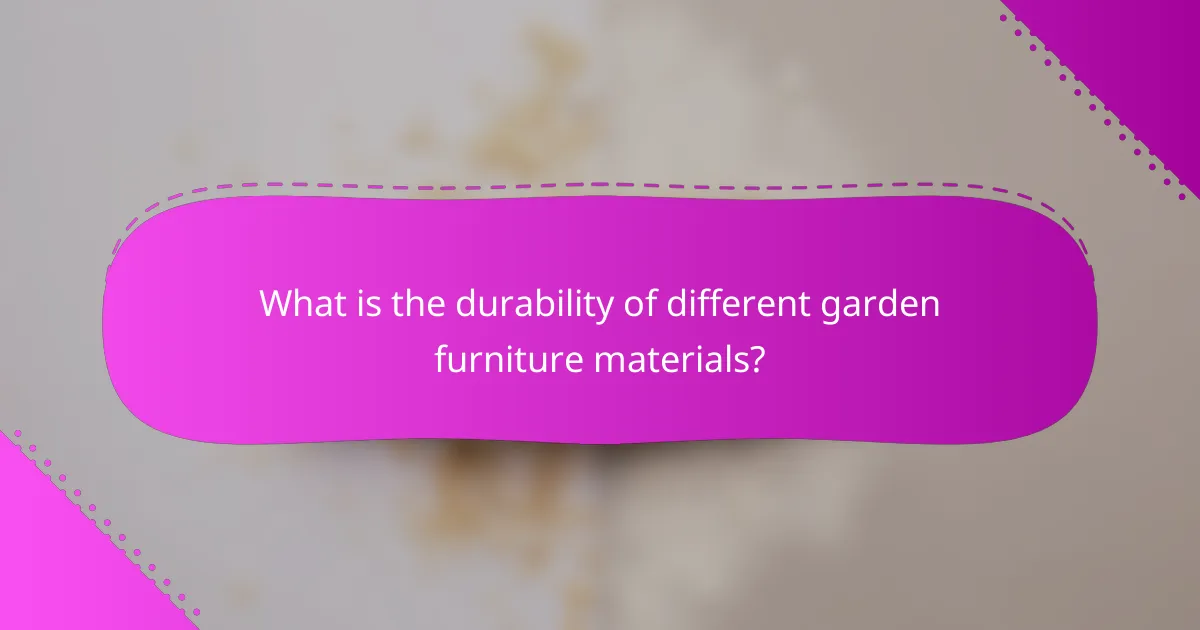
What is the durability of different garden furniture materials?
The durability of garden furniture materials varies significantly, impacting their lifespan and maintenance needs. Choosing the right material is essential for ensuring longevity and resilience against weather conditions.
Teak wood longevity
Teak wood is renowned for its exceptional durability, often lasting for decades when properly maintained. Its natural oils provide resistance to moisture, pests, and decay, making it ideal for outdoor use.
To maximize teak’s longevity, regular cleaning and application of oil can help maintain its color and prevent drying. Without care, it may weather to a silver-gray hue, which some may prefer.
Aluminum lifespan
Aluminum furniture typically boasts a long lifespan, often exceeding 10-20 years. It is lightweight, resistant to rust, and requires minimal maintenance, making it a practical choice for outdoor settings.
However, it’s important to choose high-quality aluminum, as thinner materials may bend or dent easily. Powder-coated finishes can enhance durability and protect against scratches and fading.
Wicker durability
Wicker furniture, especially when made from synthetic materials, can be quite durable, often lasting around 5-10 years outdoors. Synthetic wicker is designed to withstand UV rays and moisture, preventing fading and mold growth.
Natural wicker, while attractive, is less durable and can deteriorate quickly in wet conditions. If opting for natural wicker, ensure it is treated for outdoor use and stored properly during harsh weather.
Plastic lifespan
Plastic garden furniture generally has a lifespan of about 5-10 years, depending on the quality and exposure to sunlight. High-density polyethylene (HDPE) is a more durable option, resistant to fading and cracking.
When selecting plastic furniture, look for UV-resistant options to prolong its life. Regular cleaning can help maintain its appearance, but avoid harsh chemicals that may damage the surface.
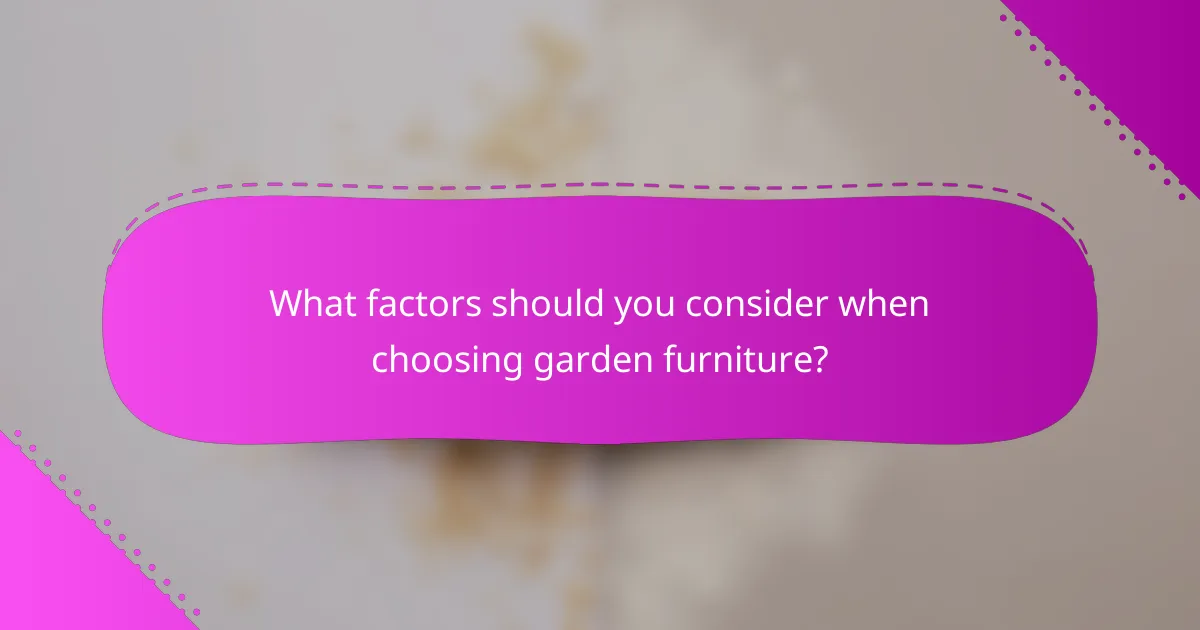
What factors should you consider when choosing garden furniture?
When selecting garden furniture, consider factors such as climate compatibility, maintenance requirements, and style. These elements will help ensure that your furniture is durable, functional, and visually appealing in your outdoor space.
Climate compatibility
Climate compatibility is crucial for the longevity of garden furniture. Different materials react differently to various weather conditions, such as humidity, rain, and UV exposure. For instance, teak and eucalyptus are excellent for humid climates, while aluminum and synthetic wicker are ideal for wet or coastal areas.
Consider the seasonal changes in your region. If you experience harsh winters, opt for materials that can withstand freezing temperatures, like metal or high-density polyethylene. Conversely, if your area is predominantly sunny, choose UV-resistant materials to prevent fading.
Maintenance requirements
Maintenance requirements vary significantly between materials. Wooden furniture often needs regular sealing or oiling to prevent rot and weather damage, while metal options may require occasional rust treatment. Synthetic materials typically require minimal upkeep, making them a convenient choice for busy homeowners.
To simplify maintenance, consider furniture that is designed for easy cleaning, such as those with removable cushions or surfaces that can be wiped down. Regularly inspect your furniture for signs of wear and address any issues promptly to extend its lifespan.
Style and aesthetics
Style and aesthetics play a vital role in choosing garden furniture, as it should complement your outdoor decor. Consider the overall theme of your garden or patio when selecting colors, shapes, and materials. For a modern look, sleek metal or glass furniture may be ideal, while traditional wooden pieces can enhance a rustic setting.
Mixing materials can also create a unique aesthetic. For example, pairing wooden tables with metal chairs can add visual interest. Always ensure that the style you choose aligns with your personal taste and enhances the overall ambiance of your outdoor space.
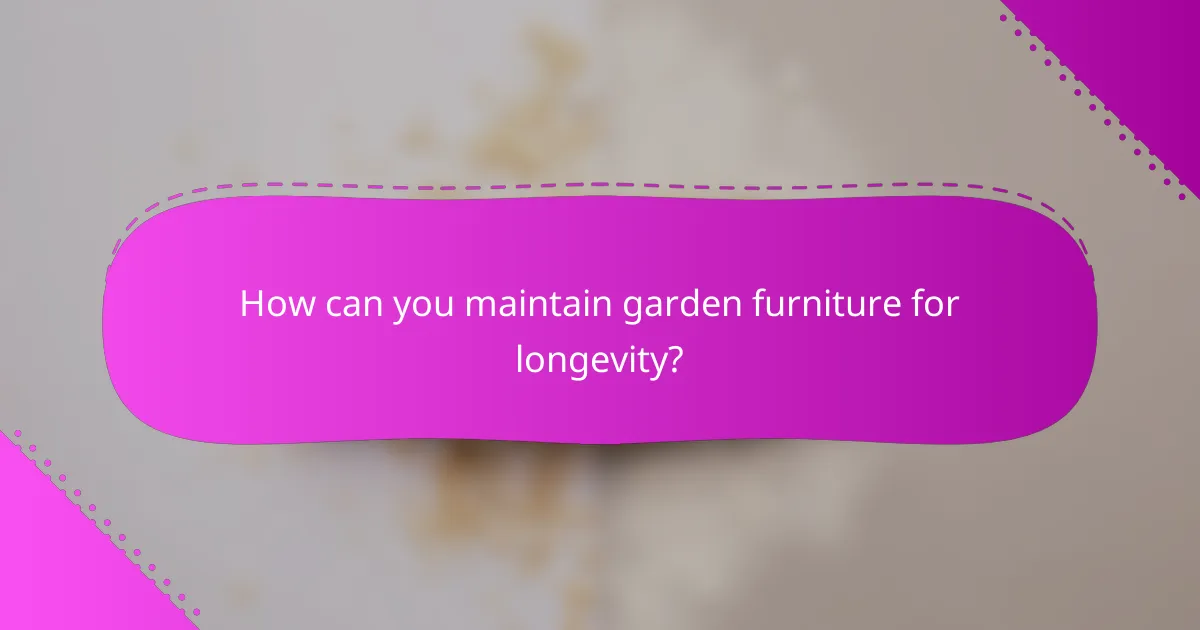
How can you maintain garden furniture for longevity?
To maintain garden furniture for longevity, regular cleaning and proper seasonal storage are essential. These practices help prevent wear and tear, ensuring that your outdoor pieces remain functional and visually appealing over time.
Regular cleaning tips
Cleaning your garden furniture regularly can significantly extend its lifespan. Use a mild soap solution and a soft brush to remove dirt and grime, and rinse thoroughly with water. For wooden furniture, consider applying a wood cleaner specifically designed for outdoor use to maintain its finish.
Be cautious with harsh chemicals or abrasive materials, as these can damage the surface of your furniture. For metal pieces, a light coat of wax can help protect against rust and corrosion, especially in humid climates.
Seasonal storage advice
Proper seasonal storage is crucial for protecting your garden furniture from harsh weather conditions. During winter, consider moving furniture indoors or using protective covers to shield it from snow and ice. If storing outside, ensure that the furniture is elevated off the ground to prevent moisture damage.
In warmer months, check for signs of wear and tear before putting furniture back outside. A quick inspection can help identify any necessary repairs or touch-ups, ensuring your furniture is ready for use when the season begins.
